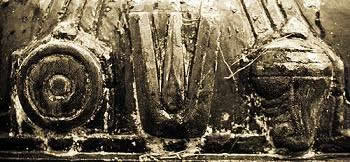KUL-DEVATA( TUTELARY DEITIES')
These ancestors of Saraswat Brahmins had accepted some of the SHAKTI deities as their KUL-DEVATA. One should remember that there is coherent difference between adoptions of the term 'deities' and 'tutelary deities' (KUL-DEVATA). A person or his family may have deity as per their inclination, convenience, and change in region etc. Sometimes, servants, protégés, refugees, appellants, mistresses, courtesans attached to the temples of their employers, worship 'tutelary deity' of their masters. But, that does not entitle them to inherit 'tutelary deity' of their masters to become member of the masters' families or their temples. 'Tutelary deity' cannot be changed for it has descended from the 'kul-purush' (the first ancestor) of a kinship, which had surrendered his life and lives his posterity to a particular deity. The tutelary deity is of the particular kinsmen. All these high caste and hard core Brahmins won't leave their tutelary deities and migrate. Later, during the 16th century, at the time of their exodus from Goa during the Catholic forceful conversions, from the Cortali and Keloshi to Antruz (Ponda praant), they took their tutelary deities first. They had brought their tutelary deities (KUL-DEVATA) from Trihotra. Names of the deities were Mangesh, Maha-Deva, Maha-Lakshmi, Mahalasa, Shanta-Durga, Nagesh and Sapt-Koteshwar.
Gaudd Saraswat Brahmins, traditionally, do not construct a temple of their own ancestors and worship them, unless he happens to be the KUL-PURUSH. None of them are God and they would consider it blasphemous to say so. That is the main reason for which the Saraswat Brahmins do not worship Bhargava Parashuram. The Saraswats termed Friday (the sixth day of a week) as 'Bhruguwaar' in the beginning, to commemorate their roots to Bhrugu Rishi. Dadhichee was a sanctified ascetic. After his martyrdom in the name of gods, the vicinity of Saraswati River faced a great deal of famine consecutively for twelve years. Even, the rivers viz. Shatadru (Sutlej) and Vyaas-Ganga (Beas) were dried up because of the dreaded famine. Consequently all, except Saraswat Brahmins left the place, known as BRAHMAA-VARTA (the location comprising of present AMBAALAA, KURUKSHETRA, JIND and HISSAR, which is towards the north-east of DELHI). This was known as SARASWAT DESH. All the Saraswats approached Lord Shiva for their survival. He told them that since he is the master of destruction, they could approach only Lord Vishnu, who was the master of balancing the life on the earth. These Brahmins were known as Saraswat, because after they descended from Kashmir, they settled down on the banks a river namely Saraswati. The area was from the source of Saraswati River to 'Binshan Teerth'.
The Gaudd Saraswat Brahmins had to face all these upheavals in course of time. They approached Lord Vishnu. He told them that he would remain in their flesh and brain in the form of fish and would save the Saraswats from extinction, as He had saved mankind during his Matsyaawataar (the first incarnation of the Lord in form of Fish). He then, assured them that He, in the form of Parashuram, the sixth incarnation of Lord Vishnu, would save them from all the wicked tyrants. Saraswati River is known as 'Naditamaa'. She could produce the staple food, as much wanted by the Saraswat Brahmins. Thus, the Saraswat Brahmins opted for fish, which was only the staple food during the course of famine and there after. This is sufficient to say that the Saraswat Brahmin knew sea-faring and fishing. They, thus, preserved their identity. The Saraswat Brahmins are brilliant in learning, if compared to the rest; it is because of their choice for fish, which is clinically proved today as a ground reality. After the famine was over, sixty thousand, among the departed, Brahmins returned to BRAHMAA-VARTA fold. They had forgotten the Brahmanistic excellence during the search for food and shelter in the wilderness. Also, in the meanwhile, elderly people had expired. The Saraswat Brahmins taught the youngsters everything, which is required for their day-today livelihood. Such learning is known as the Vedanta-paatth or the Saraswat Paatth. Later on, even Swami Adi Shankaracharya, the pontiff of Vedic Indian traditional society accepted Swami of Saraswat community, as his Guru and then took lessons from him.
Bhargava Parashuram also chose the Saraswat Brahmins from SHRAAWASTI NAGAR of north Koshal Pradesh (South Bengal), which was also known as GAUD. Hence the Brahmins from that region were also known as the Gaud Saraswat Brahmins. Gaud was known for rich heritage. The Saraswat Brahmins, who have passion for literature. They are also well known for their sharp memory. They are non-violent too.
The shat karmas or six fold acts enjoined on the Saraswat Brahmins are as follows:
1) Yajna or performing sacrifices by officiating as priests.
2) Yajna or causing the performance of the sacrifice by being the financier or the yajaman (These sacrifices were performed for the spiritual benefit of the whole human society).
3) Adhyayana or engaging oneself in academic pursuits.
4) Adhyapana or teaching.
5) Daana or giving gifts.
6) Prateegraha or accepting gifts.
The gift given, however small, must be accepted with all humility (In Marathi the priestly profession is called 'bhikshuki'). The Saraswats, therefore, also known as 'Bhatt' and 'Dikshit'. They were also known as 'Vaidya', since they ran an Ayurvedic medical clinic, in the name of Chyawan Rushi. In the course of time, they accepted the people coming from other regions, in search of shelter. They were allowed to shoulder the responsibilities of other work.
© Dr S M Tadkodkar













